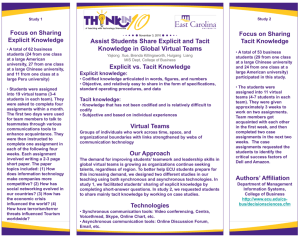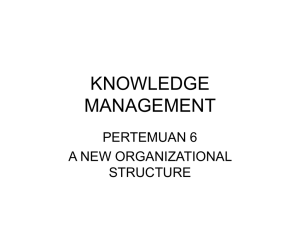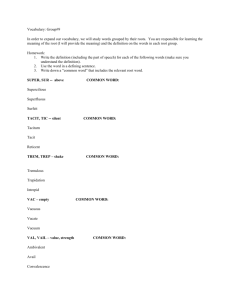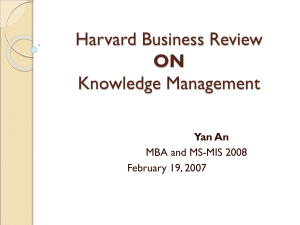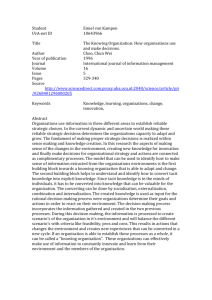Nonaka`s Four Modes of Knowledge Conversion
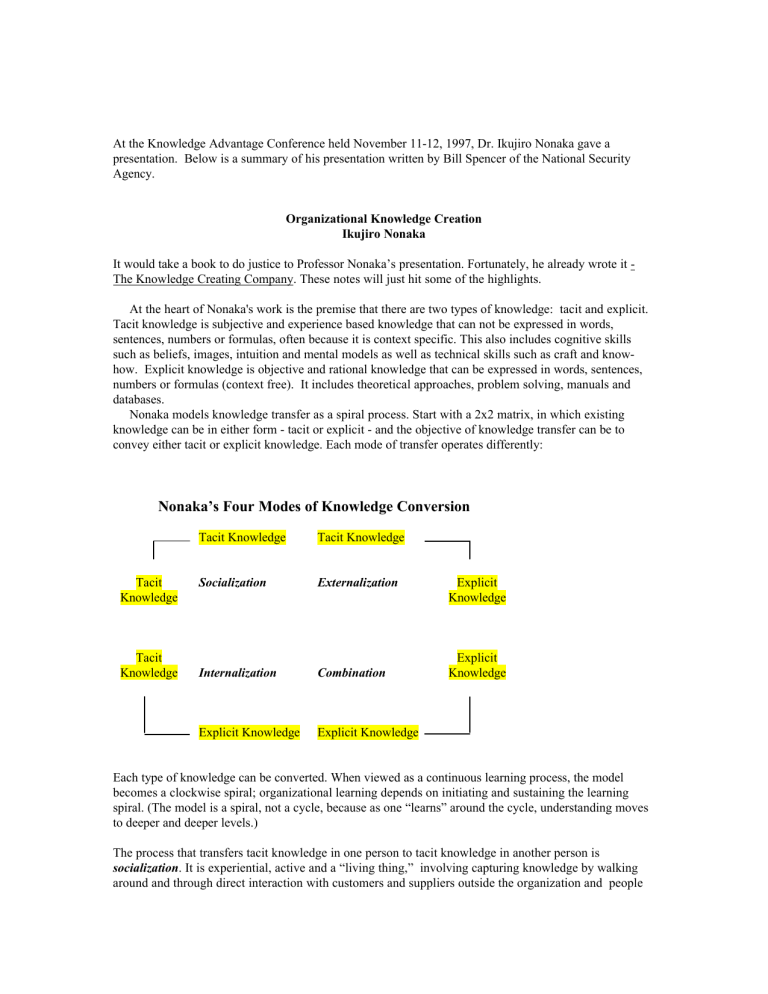
At the Knowledge Advantage Conference held November 11-12, 1997, Dr. Ikujiro Nonaka gave a presentation. Below is a summary of his presentation written by Bill Spencer of the National Security
Agency.
Organizational Knowledge Creation
Ikujiro Nonaka
It would take a book to do justice to Professor Nonaka’s presentation. Fortunately, he already wrote it -
The Knowledge Creating Company. These notes will just hit some of the highlights.
At the heart of Nonaka's work is the premise that there are two types of knowledge: tacit and explicit.
Tacit knowledge is subjective and experience based knowledge that can not be expressed in words, sentences, numbers or formulas, often because it is context specific. This also includes cognitive skills such as beliefs, images, intuition and mental models as well as technical skills such as craft and knowhow. Explicit knowledge is objective and rational knowledge that can be expressed in words, sentences, numbers or formulas (context free). It includes theoretical approaches, problem solving, manuals and databases.
Nonaka models knowledge transfer as a spiral process. Start with a 2x2 matrix, in which existing knowledge can be in either form - tacit or explicit - and the objective of knowledge transfer can be to convey either tacit or explicit knowledge. Each mode of transfer operates differently:
Nonaka’s Four Modes of Knowledge Conversion
Tacit Knowledge Tacit Knowledge
Tacit
Knowledge
Socialization Externalization Explicit
Knowledge
Tacit
Knowledge Internalization Combination
Explicit
Knowledge
Explicit Knowledge Explicit Knowledge
Each type of knowledge can be converted. When viewed as a continuous learning process, the model becomes a clockwise spiral; organizational learning depends on initiating and sustaining the learning spiral. (The model is a spiral, not a cycle, because as one “learns” around the cycle, understanding moves to deeper and deeper levels.)
The process that transfers tacit knowledge in one person to tacit knowledge in another person is socialization . It is experiential, active and a “living thing,” involving capturing knowledge by walking around and through direct interaction with customers and suppliers outside the organization and people
inside the organization. This depends on having shared experience, and results in acquired skills and common mental models. Socialization is primarily a process between individuals.
The process for making tacit knowledge explicit is externalization . One case is the articulation of one’s own tacit knowledge - ideas or images in words, metaphors, analogies. A second case is eliciting and translating the tacit knowledge of others - customer, experts for example - into a readily understandable form, e.g., explicit knowledge. Dialogue is an important means for both. During such face-to-face communication people share beliefs and learn how to better articulate their thinking, though instantaneous feedback and the simultaneous exchange of ideas. Externalization is a process among individuals within a group.
Once knowledge is explicit, it can be transferred as explicit knowledge through a process Nonaka calls combination . This is the area where information technology is most helpful, because explicit knowledge can be conveyed in documents, email, data bases, as well as through meetings and briefings. The key steps collecting relevant internal and external knowledge, dissemination, and editing/processing to make it more usable. Combination allows knowledge transfer among groups across organizations.
Internalization is the process of understanding and absorbing explicit knowledge in to tacit knowledge held by the individual. Knowledge in the tacit form is actionable by the owner. Internalization is largely experiential, in order to actualize concepts and methods, either through the actual doing or through simulations. The internalization process transfers organization and group explicit knowledge to the individual.
So, where does the Knowledge Spiral take place? Under what conditions? What is the shared mental space, the place for knowledge creation? Nonaka told us this was his current area of interest, and shared some of his thoughts.
It can be
Physical - office
Virtual - email, teleconferencing
Mental - shared experiences, ideas, beliefs
Relationship - people sharing common goals
Different kinds of spaces are conducive to the activities in each of the four knowledge transitions
Within a company, there are five enablers for knowledge creation: vision strategy structure system staff
1. A knowledge vision is a working premise for knowledge. Examples are:
3M Innovation: Thou shalt not kill a new idea.
Walt Disney: Continuous progress via creativity, dreams and imagination. No cynicism allowed.
Sharp: Opt electronics. Don't imitate, make a product to be imitated.
2. Strategy conceptualizes what knowledge to develop. Nonaka gave two contrasting aspects of strategy.
A product strategy leads to “product identification”, with fixed and separate resource perception leading to inefficient new product development. Product strategy leads to a management strategy based on physical assets. Organizations deploy product portfolios; the organization is structured as a strategic
business unit making specific products; and there is a defined product / market boundary. In short, the organization optimizes on making specific things.
Compare the product strategy with a knowledge strategy . In a knowledge strategy, identification is around core knowledge, with flexible linkage corresponding to markets. This results in efficient new product development. Additionally, with the knowledge strategy the products are linked, while in a product strategy they are separate. Management based on knowledge assets and their use focuses on creating and disseminating knowledge vs. things. Work units must be designed to facilitate and enable the selforganizing nature of knowledge. Such organizations are boundary-less, but are constrained by cognitive limits of individuals (Ed. Note - I would also add possibly constraints of time, space and place, depending upon the organization.)
3. The next enabler is system , which Nonaka describes as networking communities of knowledge, to competitors, customers, related industries, regional communities, and subsidiaries. It also includes the knowledge vision, a knowledge conversion system and processes as well as a knowledge base.
Nonaka gave Sharp as an example. Structures at Sharp include the corporate innovation system for technology and products, with a corporate technology conference whose purpose is to identify potential for technological development. One method of doing so is to identify urgent development project teams.
Such teams have broad powers to recruit personnel and procure equipment and/or facilities, are budgeted by headquarters, span more than 3 business groups, and normally have a deadline with 18 months. A visible sign of their power and authority is a Gold Badge. Additionally, this innovation system has a new planning group to focus on market needs. One way to do this are the new lifestyle planning groups, which includes collaboration on research with companies in other industries. Another group is the trend leader system of 600 leading consumers ranging from high school students to senior citizens. This group reviews new product concepts, and then breaks into smaller focus groups.
4. The fourth enabler is structure . Nonaka discussed two forms of organization, asserting that one management challenge is to maintain a balance between the fractal organization , which he categorized as self-organizing, capable of great speed and agility, and especially good at socialization and externalization . In contrast is the bureaucracy , with a hierarchy, division of labor and specialization, which is especially good at combination and internalization . Both of these are necessary. (Ed. Note - Dr.
Robert Bauer of Xerox PARC describes the authorized and emergent structure, which are comparable.)
5. The last enabler is staff . In this area, Nonaka stressed the importance of middle managers in what he called a “Middle-Up-Down Process” of knowledge transfer. The role of the middle manager is to support, nurture, care about, initiate and complete the knowledge spiral. They play the critical role between the
“Grand Theory (what ought to be)” from the top, and the “Front-line (what reality is). They translate
Grand Theory into Mid-range theory, which is then tested on the front line. Contradictions flow back to the Middle manager, which must then be communicated to and resolved with top leaders. The action in the middle is the “Cross-leveling of knowledge.”
In summary, Nonaka stated that true knowledge - actionable understanding - comes from gut-level commitment and belief. Therefore, building and conveying knowledge requires shared emotion, feeling, mental models, experiences, and what he called “empathy space.”


